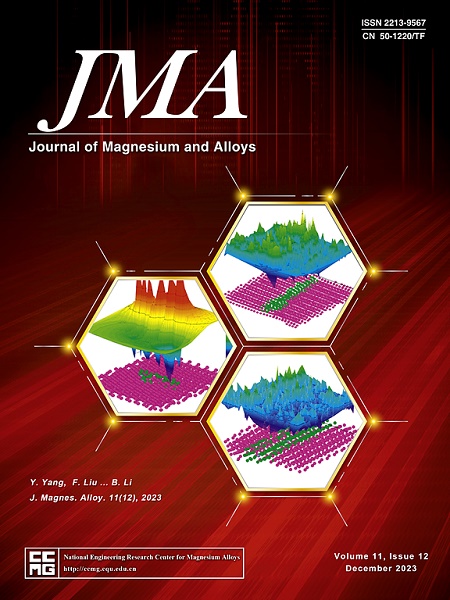Mg-2Y-1Zn合金双级热压缩变形后的软化硬化机制
IF 13.8
1区 材料科学
Q1 METALLURGY & METALLURGICAL ENGINEERING
引用次数: 0
摘要
镁合金通常采用多道次热加工方法,以克服由有限滑移系统引起的加工性能差,而有限滑移系统通常涉及复杂的变形后软化和硬化行为。为了揭示Mg-2Y-1 Zn合金变形后的软化和硬化机理,进行了双阶段热压缩试验和显微组织观察。结果表明:Mg-2Y-1 Zn合金的软化分数与变形条件呈非线性关系,可与Z参数进行一般耦合;由于孪晶和扭结的形成和交叉重叠,在300°C/0.001 s-1保温过程中,仅发生静态恢复(SRV),导致10 s后的静态软化最小,为5.52%。在400°C/0.001s-1温度下,保温10 s后试样的变形后软化率提高了11.93%,这主要是由于静态再结晶(SRX)和连续动态再结晶(CDRX)在第一次变形阶段发生以及受LPSO相影响的SRV。在400°C/0.1 s-1的变形条件下,MDRX和SRX的耦合作用导致合金在保温10 s后应力松弛严重,松弛率达42.83%,并在再加载阶段产生硬化现象。18R-LPSO和14H-LPSO相同时影响再结晶晶粒的变形行为和生长。基于Johnson-Mehl-Avrami-Kolmogorov方程建立了简化的静态软化动力学模型,并对实验数据进行了合理化处理。本文章由计算机程序翻译,如有差异,请以英文原文为准。

The post-deformation softening and hardening mechanisms of a Mg-2Y-1Zn alloy during double-stage hot compression
Multi-pass hot processing methods are commonly used in magnesium (Mg) alloys to overcome the poor workability due to limited slip systems, which generally involve complicated post-deformation softening and hardening behaviors. In this work, to reveal post-deformation softening and hardening mechanisms of a Mg-2Y-1 Zn alloy, double-stage hot compression tests and microstructural observations were conducted. The results showed that the softening fraction of Mg-2Y-1 Zn alloy showed a non-linear dependence on deformation conditions and could be general coupled by Z parameter. Due to the formation and cross-overlapping of twins and kinks, only static recovery (SRV) occurred during holding process at 300 °C/0.001 s-1 which led to the least static softening: 5.52 % after 10 s of holding. For samples at 400 °C/0.001s-1, the enhanced post-deformation softening, which is 11.93 % after 10 s of holding, was attributed to static recrystallization (SRX) followed continuous dynamic recrystallization (CDRX) happened during first deformation stage as well as SRV influenced by the LPSO phases. Under deformation condition of 400 °C/0.1 s-1, the coupled meta-dynamic recrystallization (MDRX) and SRX resulted in serious stress relaxation, which is 42.83 % after 10 s of holding, and caused hardening phenomenon at reloading stage. The 18R-LPSO and 14H-LPSO phases synchronously worked on deformation behaviors and limited the growth of recrystallized grains. Further, a simplified static softening kinetics model was established based on Johnson-Mehl-Avrami-Kolmogorov equation and employed to rationalize experimental data.
求助全文
通过发布文献求助,成功后即可免费获取论文全文。
去求助
来源期刊

Journal of Magnesium and Alloys
Engineering-Mechanics of Materials
CiteScore
20.20
自引率
14.80%
发文量
52
审稿时长
59 days
期刊介绍:
The Journal of Magnesium and Alloys serves as a global platform for both theoretical and experimental studies in magnesium science and engineering. It welcomes submissions investigating various scientific and engineering factors impacting the metallurgy, processing, microstructure, properties, and applications of magnesium and alloys. The journal covers all aspects of magnesium and alloy research, including raw materials, alloy casting, extrusion and deformation, corrosion and surface treatment, joining and machining, simulation and modeling, microstructure evolution and mechanical properties, new alloy development, magnesium-based composites, bio-materials and energy materials, applications, and recycling.
 求助内容:
求助内容: 应助结果提醒方式:
应助结果提醒方式:


